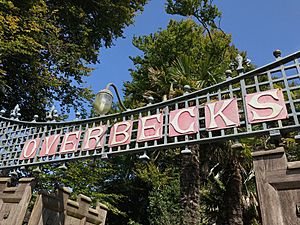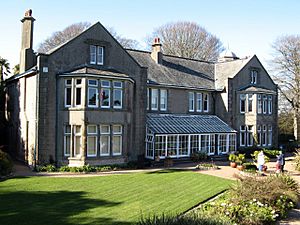Overbeck's facts for kids
Overbeck's Garden at Sharpitor is a beautiful garden in Salcombe, Devon, England. It covers about 2.75 hectares (7 acres). This special place is known for its amazing subtropical plants. It's named after its last private owner, Otto Overbeck.
The story of Overbeck's began with a small house called "Sharpitor." A local builder, Albert Stumbles, built it. In 1901, Edric Hopkins bought the house. He also bought more land, about 2 acres, to start the garden. He created terraces and planted many unique, exotic plants. These plants loved the sheltered spot.
In 1913, Mr and Mrs George Medlicott Vereker bought the property. They built the larger house you see today. Otto Overbeck then bought the house in 1928. He lived there until he passed away in 1937. Otto Overbeck wanted the house to be used for everyone. He hoped it would become a public park, a museum, and a place for young people to stay. The National Trust accepted his generous gift.
For many years, the house had two parts. One part was a museum. The other part was a youth hostel. The youth hostel closed in 2014. The museum also closed its doors in 2020.
Discovering the Former Museum
The museum at Overbeck's used to show many interesting things. It displayed some of Otto Overbeck's own inventions. There were also collections of stuffed animals. Visitors could see model sailing ships. Various tools used for boats and shipbuilding were also on display. Many of these sea-related items are now at the Salcombe Maritime Museum.
One special room in the house had a "secret" door. It was hidden in the wooden walls. This room held a collection of dolls' houses. Children loved to search for "Fred the friendly ghost" among them. The museum also had a large musical box called a Polyphon. It played music from big metal discs. There were many old songs from the Edwardian era. These were often played for visitors. The museum also showed old photographs. These pictures were taken by Edward Chapman. He photographed Salcombe in the early 1900s. He even captured the building of the first house on this site.
Exploring the Amazing Garden
The garden at Overbeck's is truly special. Edric Hopkins started it, and later owners helped it grow. It has become a home for many delicate plants. These plants usually grow in warm places. They come from the Mediterranean and Australia. The garden has a unique "microclimate." This means it has its own small weather system. It's protected on the edge of the Kingsbridge Estuary. This allows many unusual plants to thrive.
The National Trust has identified several different garden areas. Each area has its own charm.
- The Gazebo Garden is a lovely spot to relax.
- The Statue Garden used to be a tennis court.
- The Old Quarry provided stone for the house.
- The Olive Grove is filled with olive trees.
- The Banana Garden often grows real bananas.
- The Terraces offer beautiful views.
- The Orange Tree Store is a glasshouse. It protects the orange tree in winter.
- The Woodland Garden is a peaceful, shady area.
You can find more details about the garden's history. Information about the gardeners is also available. This can be found on the Historic England website.



